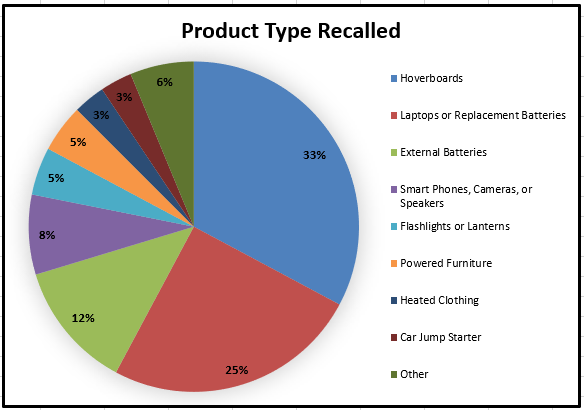Recalls in Review: A monthly spotlight on trending regulatory enforcement issues at the CPSC.
If you have ever owned a laptop or hoverboard self-balancing scooter, you’ve likely seen numerous headlines about the lithium-ion batteries overheating, melting, or igniting. We recently wrote about ways in which companies can mitigate risks and execute recalls related to lithium ion batteries. In today’s installment of “Recall’s in Review,” we look back at CPSC regulatory actions involving lithium-ion batteries.
The batteries have become a highly regulated product over the last several years. The Commission has conducted at least 64 recalls involving lithium-ion batteries since 2006. The number of recalls rose substantially in 2016 and 2017, many of which were related to the rechargeable lithium-ion batteries inside hoverboards and laptop computers. The Commission took a more active role in warning consumers about the hazards posed by the batteries after two incidents of overheating lead to serious house fires in March and October of 2017.
Only one civil penalty relating to lithium-ion batteries has been issued by the Commission, in early 2012. The manufacturer was fined $425,000 for failure to timely report that certain lithium-ion battery packs could overheat.
Rechargeable lithium-ion batteries are used in a wide variety of products. Although a large proportion of the relevant recalls involve hoverboards and laptop computers, we have also seen recalls for the batteries included in: external battery packs and chargers, smart phones, cameras, flashlights, lanterns, powered furniture, heated clothing, car jump starters, and more. Consumers should check products with rechargeable batteries to determine the type of battery and keep an eye on any products with lithium-ion batteries.
Nearly all of the 64 recalls were conducted due to potential for the batteries to overheat, melt, or burst, posing fire and burn hazards to consumers. One recall cited a potential for fire without providing a reason, and one other recall provided that the risk of fire was caused by conductive foreign material being mixed into the battery cell during manufacturing.
Recall announcements vary as to whether they include instructions regarding how to dispose of the battery. Many indicate that the product (or battery) should be returned in exchange for a replacement product or refund. A handful indicate that the batteries should be disposed of according to state and local laws. The most common remedy offered by recalling firms is a replacement product or battery, followed by a refund or store credit. Less often, the remedy may be limited to a free repair.
* * * * *
About Recalls in Review: As with all things, but particularly in retail, it is importantly to keep your finger on the pulse of what’s trending with consumers. Regulatory enforcement is no different – it can also be subject to pop culture trends and social media fervor. And this makes sense, as sales increase for a “trending” product, the likelihood of discovering a product defect or common consumer misuse also increases. Regulators focus on popular products when monitoring the marketplace for safety issues.
As product safety lawyers, we follow the products that are likely targets for regulatory attention. Through Recalls in Review, we share our observations with you.
"Review" - Google News
November 05, 2020 at 04:21AM
https://ift.tt/3et0tGN
Recalls in Review: Lithium-ion Batteries - Retail & Consumer Products Law Observer
"Review" - Google News
https://ift.tt/2YqLwiz
https://ift.tt/3c9nRHD
Bagikan Berita Ini


















0 Response to "Recalls in Review: Lithium-ion Batteries - Retail & Consumer Products Law Observer"
Post a Comment